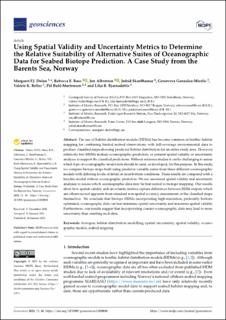| dc.contributor.author | Dolan, Margaret | |
| dc.contributor.author | Ross, Rebecca | |
| dc.contributor.author | Albretsen, Jon | |
| dc.contributor.author | Skardhamar, Jofrid | |
| dc.contributor.author | Gonzalez-Mirelis, Genoveva | |
| dc.contributor.author | Bellec, Valerie Karin | |
| dc.contributor.author | Buhl-Mortensen, Pål | |
| dc.contributor.author | Bjarnadóttir, Lilja Rún | |
| dc.date.accessioned | 2021-06-18T12:39:05Z | |
| dc.date.available | 2021-06-18T12:39:05Z | |
| dc.date.created | 2021-04-14T16:28:11Z | |
| dc.date.issued | 2021 | |
| dc.identifier.citation | Geosciences. 2021, 11 (2), 1-38. | en_US |
| dc.identifier.issn | 2076-3263 | |
| dc.identifier.uri | https://hdl.handle.net/11250/2760188 | |
| dc.description.abstract | The use of habitat distribution models (HDMs) has become common in benthic habitat mapping for combining limited seabed observations with full-coverage environmental data to produce classified maps showing predicted habitat distribution for an entire study area. However, relatively few HDMs include oceanographic predictors, or present spatial validity or uncertainty analyses to support the classified predictions. Without reference studies it can be challenging to assess which type of oceanographic model data should be used, or developed, for this purpose. In this study, we compare biotope maps built using predictor variable suites from three different oceanographic models with differing levels of detail on near-bottom conditions. These results are compared with a baseline model without oceanographic predictors. We use associated spatial validity and uncertainty analyses to assess which oceanographic data may be best suited to biotope mapping. Our results show how spatial validity and uncertainty metrics capture differences between HDM outputs which are otherwise not apparent from standard non-spatial accuracy assessments or the classified maps themselves. We conclude that biotope HDMs incorporating high-resolution, preferably bottom-optimised, oceanography data can best minimise spatial uncertainty and maximise spatial validity. Furthermore, our results suggest that incorporating coarser oceanographic data may lead to more uncertainty than omitting such data. | en_US |
| dc.language.iso | eng | en_US |
| dc.title | Using Spatial Validity and Uncertainty Metrics to Determine the Relative Suitability of Alternative Suites of Oceanographic Data for Seabed Biotope Prediction. A Case Study from the Barents Sea, Norway | en_US |
| dc.type | Peer reviewed | en_US |
| dc.type | Journal article | en_US |
| dc.description.version | publishedVersion | en_US |
| dc.source.pagenumber | 1-38 | en_US |
| dc.source.volume | 11 | en_US |
| dc.source.journal | Geosciences | en_US |
| dc.source.issue | 2 | en_US |
| dc.identifier.doi | 10.3390/geosciences11020048 | |
| dc.identifier.cristin | 1904128 | |
| cristin.ispublished | true | |
| cristin.fulltext | original | |
| cristin.qualitycode | 1 | |
